This was published 1 year ago
Why you should visit this unknown, Manhattan-esque district of Paris
We won’t forget this petit-dejeuner in a hurry. As we devour still-warm croissants and pains au chocolat, chunks of baguette slathered in butter and jam, super creamy yoghurt trickled with honey, zesty orange juices and cafes au lait, Paris is providing the perfect backdrop. “Look, there’s the Sacre-Coeur! And the Arc de Triomphe! And, you know ...”
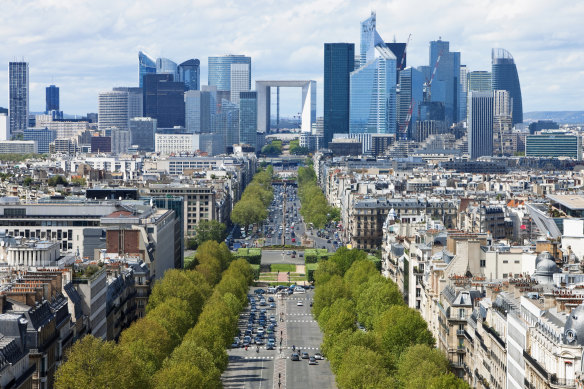
Manhattan vibes of La Defense.Credit: iStock
Yes, the Eiffel Tower is doing its thing, lording it over the French capital. Breakfast at the 14th floor Mama’s Penthouse is a highlight of our stay at Mama Shelter La Defense, a cool hotel where Paris’ genteel western suburbs meet Europe’s largest purpose-built business district, its skyscrapers shimmering above the River Seine.
A chain hotel with character – funky fabrics and artefacts are liberally scattered about – Mama Shelter is good value for a notoriously expensive city. Nightly rates are from about €110 ($180), with some of the 211 rooms and suites flaunting Parisian panoramas, including our 20-square-metre Medium Mama Double Absolute.
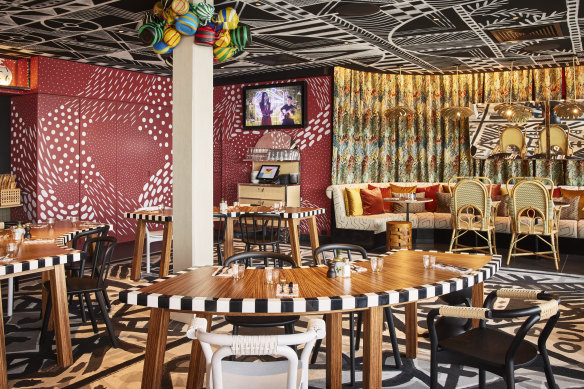
Fun, quirky and central: Mama Shelter, La Defense, Paris.
You can be in the heart of the city, queuing for its major tourist sights, within half an hour. The hotel is around the corner from Esplanade de la Defense station, with Metro Line 1 linking to the Louvre Museum and Notre Dame cathedral (plus connections to Montmartre, Pigalle and other pleasing neighbourhoods). You can also hire an e-bike and pedal to central Paris along segregated new cycle lanes.
Yet, while it’s tempting to rush off, La Defense rewards wanderers, particularly those interested in architecture, urban design and contemporary art (you’ll find France’s biggest open-air gallery here). Blending Brutalism with Surrealism, glass-and-steel with pockets of leafiness, La Defense is about as un-Parisian as it gets, although technically, you’re outside the city limits. This expanding district covers three historic communes, Courbevoie, Puteaux and Nanterre, each with its own hotel de ville (town hall), high streets and distinctive signage.
“La Defense has changed so much since I was a kid,” says my partner, Celine, who grew up here, the Manhattan-esque skyline sprouting outside our bedroom window. The first towers shot up in the late 1950s, there was another burst in the 1970s, and the past decade has witnessed an even glossier cluster, driven in part by Brexit, as planners anticipated an influx of business from the UK.
When La Defense was first mooted, it was hoped it could eventually rival the City of London. It’s now home to more than 500 companies, including top French and multinational corporations, SMEs and start-ups, with almost 4million square metres of office space and 180,000 employees and co-workers. Some are taking cigarette breaks, texting and chatting as we amble on Le Parvis, the district’s elevated car-free esplanade, from which shaded lanes and stairways spring off.
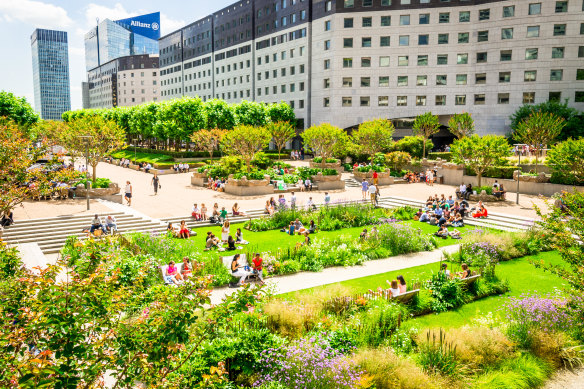
La Defense is about as un-Parisian as it gets.Credit: Alamy
“That’s new,” says Celine, pointing up at Tour Saint-Gobain, a 44-storey tower capped by a cantilevered block, completed in 2019. “And I don’t remember that,” she adds, nodding towards Tour Majunga (2014), with its wavy, zig-zagging facade. Another glassy 21st century standout is Tour D2, which has a public rooftop garden and a resemblance to London’s Gherkin and Barcelona’s Torre Glories. Star French architect Jean Nouvel designed the latter and masterminded Tour Hekla, a 220-metre showstopper completed in 2022 and now La Defense’s second loftiest tower after the revamped Tour First (231m).
Eight of the 10 highest buildings in Paris’ metropolitan sprawl loom in this district. We saw the other two at breakfast. Lurking behind Eiffel’s 300-metre “metal asparagus” was Tour Montparnasse, a monolithic 210-metre “tombstone” that caused such ire when it was unveiled in the 14th arrondissement in 1973 that the authorities decreed that nothing over seven storeys should be built in the city any more.
This turbocharged La Defense’s development and ensured Paris remained quintessentially Parisian, dominated by elegant 19th-century Haussmann-style architecture. Though the edict was scrapped in 2015, only certain types of skyscrapers, within certain parts of Paris, will be tolerated, largely by the Boulevard Peripherique ring road (Tours Duo, another high-rise by Nouvel, now sparkles on Paris’ eastern edge).
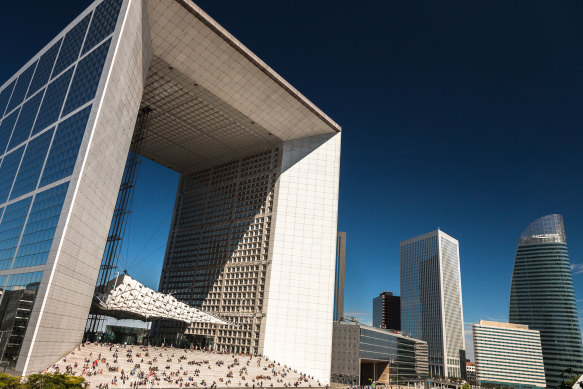
The Grande Arche is more than double the height of Napoleon’s Arc de Triomphe, from which it took inspiration.Credit: Alamy
I’m enjoying Celine’s trip down memory lane, her off-the-cuff observations, and the sporadic information boards, which detail, in French and English, La Defense’s evolution. You can also book guided walking tours with architecture experts. Many gather by the Grande Arche, a landmark by Johann Otto von Spreckelsen, a Dane who won a 1982 design competition launched by President Francois Mitterrand.
Combining offices, photojournalism exhibition spaces and a panoramic terrace restaurant, this hollow 110-metre cube is more than double the height of Napoleon’s Arc de Triomphe, from which it took inspiration. Visible from each other and four kilometres apart, they stand on Paris’ historical axis, which threads via the Champs-Elysees and other monument-fringed thoroughfares.
On Bastille Day 1990, 2.5 million revellers flocked to the Grande Arche for a concert by Jean-Michel Jarre, with fireworks marking the 200th anniversary of the French Revolution. Scaling steps to this monument’s void, we look west towards La Defense Arena, a smart modern venue designed by Pritzker Prize winning architect Christian de Portzamparc. It staged Bruce Springsteen and Celine Dion concerts last year and will host swimming events for the 2024 Olympic and Paralympic Games.
Heading back down the Grande Arche, Celine leads me to The Thumb. This supersized bronze digit by Cesar Baldaccini, an old mate of Pablo Picasso, is one of almost 70 pieces in La Defense’s alfresco art collection (more appear during temporary summer exhibitions). The Red Spider by American sculptor Alexander Calder is another permanent fixture, near the Centre of New Industries and Technologies (CNIT), a multi-use building with a striking vaulted roof, inaugurated by President Charles de Gaulle in 1958. Joan Miro’s typically outlandish Fantastic Characters contorts outside Westfield Les Quatre-Temps, a monster mall with more than 200 stores, cinemas and a food court including French, Lebanese and Vietnamese eateries.
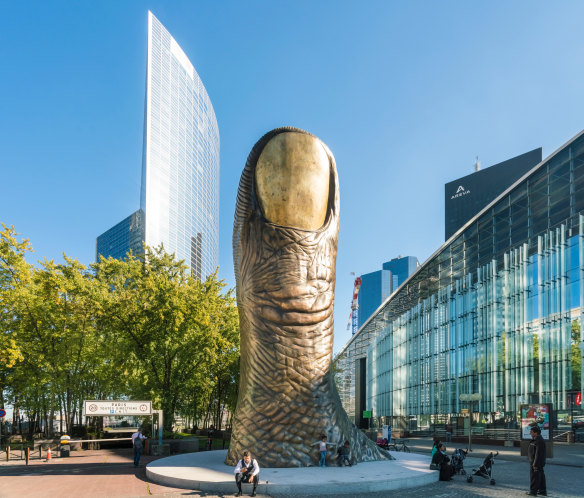
The Thumb is a supersized bronze digit by Cesar Baldaccini.Credit: Alamy
The most incongruous artwork is the bronze statue that gives the district its name. Commemorating the victims of the Siege of Paris in the 1870 Franco-Prussian war, La Defense de Paris was hewn by Louis-Ernest Barrias, who beat numerous rivals, including Auguste Rodin, for the commission. “I never noticed this before,” says a puzzled-looking Celine. In fairness, it arrived here only in 2017, from another location in Paris.
A hip neighbourhood addition is Oxygen, with cocktails and “bistronomy” in its bamboo-clad pavilions and Parisian vistas from its terraces. Mama Shelter’s penthouse is another buzzy evening spot, with DJs, drinks and fusion dishes by chef Pierre Chomet (La Defense, incidentally, now has 2600 hotel rooms, with another 800 expected by 2026).
“La Defense used to be quite dead, especially at night and at weekends, but it’s so much livelier these days,” says Celine, as we pass food trucks and young families out for a stroll. About 42,000 people now live there, a similar number attend the local higher education institutions, and thousands more pour through daily via the big transport hub (Metro lines, suburban rail and a coach station, Terminal Jules Verne, bustle below).
La Defense has been on quite the journey and it’ll have changed again before our next visit. Plans are afoot to “green” up this urban jungle, furnishing it with more trees, flowers and eco-gardens, beautifying what is already a unique and quirkily photogenic enclave. And, of course, the great thing is, when you’ve had your fill, Paris is on the doorstep.
Five other highlights in and around La Defense
Puteaux and Courbevoie
For a more classic French feel, including family-run boulangeries, patisseries and epiceries, potter along these town high streets.
Ile De La Grande Jatte
Wander around this tree-shaded island in the Seine, once the subject of paintings by Claude Monet and George Seurat.
Bois de Boulogne
Spread over former royal hunting grounds, this huge park can be reached via a bridge spanning another Seine island, Ile de Puteaux.
Neuilly-Sur-Seine
Loop back to La Defense via this affluent district, characterised by its attractive low-rise mansions and foreign embassies.
Festivals
Free outdoor concerts fuel La Defense’s July summer jazz festival, while December’s Christmas market has 300-odd themed chalets.
The details
Fly
Emirates flies to Paris from Sydney and Melbourne via Dubai.
Stay
Mama Shelter Paris La Defense, 10 Rue Jean Jaures, 92800 Puteaux. See mamashelter.com/paris-la-defense
More
Sign up for the Traveller Deals newsletter
Get exclusive travel deals delivered straight to your inbox. Sign up now.